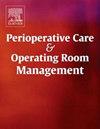映射灵活的内窥镜消毒周期表明需要降低任务复杂性和环境压力的风险策略
IF 1
Q2 Nursing
Perioperative Care and Operating Room Management
Pub Date : 2025-01-31
DOI:10.1016/j.pcorm.2025.100478
引用次数: 0
摘要
内窥镜如果消毒不当,有很大的感染风险。我们绘制了正确消毒内窥镜所需的全部任务,并进行了理论风险建模,以确定在此过程中错误风险最大的任务。方法对某医院院内的手术室、消毒前清洗侧、消毒后清洗侧和库房进行观察。确定每个空间的任务总数和压力水平。每个任务的错误率都是基于史密斯的教科书《可靠性、可维护性和风险》第7版中的复杂性量表。低压力环境下的任务每种任务类型的错误率最低,而高压力环境下的任务每种任务类型的错误率最高。通过将所有分配的任务错误率相加,计算每个空间的错误风险得分(RES)和总体RES。结果对22个柔性内窥镜进行了观察。确定了75项任务。每一个都是由人类完成的。在无菌加工中,有52项任务的压力得分最高,复杂的非常规任务数量也最多。每个内窥镜的总RES。为3.0832,大部分风险(94%)映射到无菌处理(RES为2.918)。结论内窥镜的正确消毒包括75项任务。大多数RES映射到高应力SPD环境。减少压力水平和该领域任务复杂性的策略将显著降低消毒错误的风险。本文章由计算机程序翻译,如有差异,请以英文原文为准。
Mapping the Flexible Endoscope Disinfection Cycle indicates the Need for Risk Reduction Strategies for Task Complexity and Environmental Stressors
Introduction
Endoscopes carry a significant infectious risk if not properly sterilized. We mapped the total tasks required to properly sterilize an endoscope and conducted theoretical risk modeling to define tasks at greatest risk for error in this process.
Methods
observations were conducted on a hospital campus in the following spaces: operating room, sterile processing pre-washer side, sterile processing post-washer side, and storage. The total number of tasks and the stress level in each space were determined. Each task was assigned an error rate based on a complexity scale in Smith's textbook Reliability, Maintainability and Risk, 7th Ed. Tasks in low stress spaces were assigned the lowest possible error rate per task type and those in high stress environments were assigned the highest error rate per task type. Risk of error score (RES) for each space and an overall RES was calculated by adding up all the assigned task error rates.
Results
observations were conducted on 22 flexible endoscopes. Seventy-five tasks were identified. Each was performed by a human. Fifty-two tasks were performed in sterile processing which had the highest stress score and highest number of complicated, non-routine tasks. The aggregate RES per endoscope. was 3.0832 The majority of risk (94.%) mapped to sterile processing (RES of 2.918).
Conclusions
proper sterilization of endoscopes involves 75 tasks. The majority of the RES maps to the high stress SPD environment. Strategies that reduce stress levels and the complexity of tasks in this space would significantly reduce the risk of errors in sterilization.
求助全文
通过发布文献求助,成功后即可免费获取论文全文。
去求助
来源期刊

Perioperative Care and Operating Room Management
Nursing-Medical and Surgical Nursing
CiteScore
1.30
自引率
0.00%
发文量
52
审稿时长
56 days
期刊介绍:
The objective of this new online journal is to serve as a multidisciplinary, peer-reviewed source of information related to the administrative, economic, operational, safety, and quality aspects of the ambulatory and in-patient operating room and interventional procedural processes. The journal will provide high-quality information and research findings on operational and system-based approaches to ensure safe, coordinated, and high-value periprocedural care. With the current focus on value in health care it is essential that there is a venue for researchers to publish articles on quality improvement process initiatives, process flow modeling, information management, efficient design, cost improvement, use of novel technologies, and management.
 求助内容:
求助内容: 应助结果提醒方式:
应助结果提醒方式:


